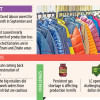BGMEA chief quizzed by US agency on price rise of apparel items

The president of the Bangladesh Garment Manufacturers and Exporters Association (BGMEA) yesterday faced a barrage of questions from the United States International Trade Commission (USITC) during a hearing.
The hearing came as part of the USITC's investigation into the sudden rise in per unit import prices of garment items exported from Bangladesh, Cambodia, India, Indonesia and Pakistan, initiated in December last year.
While attending the hearing via a virtual platform, BGMEA President Faruque Hassan faced questions about the sources of yarn and cotton, environment, social and governance (ESG) measures, productivity, labour rights, salary payments, wage structure, and skills development of garment workers.
In reply, the BGMEA chief said they had been complying with all kinds of ESG and other measures and that they had strengthened workplace safety as per the recommendations made by the "Accord" and "Alliance".
"Local garment factories have been using the latest types of machinery to run their units, which have more production capacity and significantly reduce the physical burden on workers," he added.
Hassan was also asked about the cost of production in Bangladesh, amendment of the labour law, trade unions, and labour rules. In particular, the USITC asked why there are fewer trade unions in garment factories in Bangladesh than there are in Cambodia.
He explained that all export-oriented garment factories had trade unions in line with requirements from international retailers and brands. Moreover, he added, the government has already amended the labour law twice and more reforms are being considered.
He explained the rise in the per unit price of Bangladeshi garment items is a consequence of higher raw material costs.
"We have done everything as per your recommendations but unfortunately your buyers are not paying fair prices for products."
Hassan also urged the USITC to include garment items in the duty-free import category.
Currently, the American government allows duty benefits to 97 percent of products imported from LDCs. However, Bangladeshi-made garment items are not included among them.
As a result, Bangladeshi garment exporters face one of the highest duties to the US market at 15.62 percent, whereas the duty structure for other countries hovers around 1 to 3 percent, he added.
Hassan also asked USITC officials to at least allow duty-free access for Bangladeshi garment items made from American cotton since the government had stopped the long-standing double-fumigation requirement of US cotton as per recommendations made by the BGMEA and US government last year.
Hassan said he had already written letters to local governments of states in the US where cotton was grown.
Currently, the US meets more than 12 percent of Bangladesh's annual demand for cotton, which stands at a total of 9 million bales.
Moreover, the US has not reinstated the GSP status for Bangladesh although the government has followed and implemented the 16 conditions outlined when the status was suspended following the Rana Plaza building collapse in April 2013.
In his testimony, Hassan also said that looking at US apparel imports between 2013 and 2023 shows that America's import from the world in terms of US dollar value declined by 0.25 percent, while it increased by 3.95 percent from Bangladesh.
In terms of quantity, that is in square metre equivalent, import from the world to the US declined by 0.20 percent, while import from Bangladesh grew by 2.93 percent.
He also said during 2013-2023, Bangladesh's unit price has gained 0.99 percent, while the global average unit price paid by the US has declined by 0.04 percent.
Bangladesh's unit price to the US has followed a moderate upwards trend since 2017. The average unit price in 2017 was $2.74 while it increased to $3.23 dollars in 2023.

 For all latest news, follow The Daily Star's Google News channel.
For all latest news, follow The Daily Star's Google News channel. 









Comments